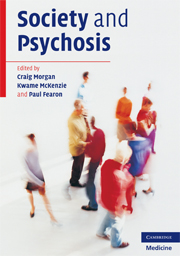Book contents
- Frontmatter
- Contents
- Contributors
- Acknowledgements
- 1 Introduction
- 2 Climate change in psychiatry: periodic fluctuations or terminal trend?
- Part I Theoretical and conceptual foundations
- Part II Social factors and the onset of psychosis
- 6 Society, place and space
- 7 Childhood adversity and psychosis
- 8 Family environment and psychosis
- 9 Adult adversity: do early environment and genotype create lasting vulnerabilities for adult social adversity in psychosis?
- 10 Migration, ethnicity and psychosis
- Part III Social factors and the outcome of psychosis
- Part IV Models and conclusions
- Index
- References
9 - Adult adversity: do early environment and genotype create lasting vulnerabilities for adult social adversity in psychosis?
from Part II - Social factors and the onset of psychosis
Published online by Cambridge University Press: 07 December 2009
- Frontmatter
- Contents
- Contributors
- Acknowledgements
- 1 Introduction
- 2 Climate change in psychiatry: periodic fluctuations or terminal trend?
- Part I Theoretical and conceptual foundations
- Part II Social factors and the onset of psychosis
- 6 Society, place and space
- 7 Childhood adversity and psychosis
- 8 Family environment and psychosis
- 9 Adult adversity: do early environment and genotype create lasting vulnerabilities for adult social adversity in psychosis?
- 10 Migration, ethnicity and psychosis
- Part III Social factors and the outcome of psychosis
- Part IV Models and conclusions
- Index
- References
Summary
Introduction
It has long been acknowledged that adult stress is an important factor in the development of psychosis. The vulnerability–stress model (Nuechterlein and Dawson, 1984) has been widely accepted as a heuristically useful framework for the study of the aetiology and clinical course of schizophrenia. According to this model, psychiatric symptoms emerge when a threshold of stressors exceeds the individual's vulnerability level, the latter being a stable within-person characteristic (Zubin et al., 1983). However, despite the apparent agreement that adult stress is a component cause contributing to psychosis, only a limited amount of research is available addressing the question of how stressors impact on vulnerable individuals. The mechanisms underlying the association between life stress and psychosis thus remain unclear.
In this chapter, we will first give an overview of evidence concerning adult adversity and risk of psychosis. In the second part, two possible ways of approaching the question of how the adult environment interacts with the individual to increase the risk of psychosis will be discussed. First, we will ask whether the impact of the adult environment on the risk of psychosis reflects the expression of a lasting vulnerability for adult stress caused by adversity early in life (we will refer to this as behavioural sensitisation). We hypothesise that exposure to early developmental exposures, such as childhood trauma and growing up in an urban environment, increase vulnerability for psychosis by sensitising people to later adverse events.
Keywords
- Type
- Chapter
- Information
- Society and Psychosis , pp. 127 - 142Publisher: Cambridge University PressPrint publication year: 2008
References
- 4
- Cited by



